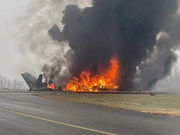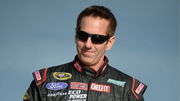
Getty
DAYTONA BEACH, FLORIDA – JANUARY 12: Dale Earnhardt Jr., driver of the #5 Hendrick Motorsports Chevrolet, speaks to the Media during the NASCAR Next Gen Test at Daytona International Speedway on January 12, 2022 in Daytona Beach, Florida. (Photo by James Gilbert/Getty Images)

Getty
DAYTONA BEACH, FLORIDA – JANUARY 12: Dale Earnhardt Jr., driver of the #5 Hendrick Motorsports Chevrolet, speaks to the Media during the NASCAR Next Gen Test at Daytona International Speedway on January 12, 2022 in Daytona Beach, Florida. (Photo by James Gilbert/Getty Images)
Folks, NASCAR has seen aggressive drivers in most eras of racing. We have all seen punches thrown, helmets pulled out, and ugly confrontations on pit road after drivers bump fenders or trade paint. But do you know where it all started? It started with the hot-headed member of the Alabama gang, Bobby Allison. In the 1979 Daytona 500, Donnie Allison and Cale Yarborough got into a wreck on the last lap, which led to both of them losing the race. King Petty won the race. Bobby Allison, who was one lap down, stopped to see if his brother Donnie needed a ride back to the garage. But a furious Yarborough came to attack them. And the trackside just turned into a ring with kicks and punches thrown. Cale had hit Bobby in the nose with his helmet, and things just kept escalating! That was another era.
Watch What’s Trending Now!
But now, only a few names spark eye rolls faster than Kris Wright’s. Known more for his unfortunate involvement in wrecks than race wins, Wright has become something of a magnet for controversy, especially when the stakes are high. What should’ve been a battle among contenders at Texas turned into chaos when Wright, several laps down, clashed with Justin Allgaier in a moment that lit up social media. And let’s just say, fans weren’t the only ones fuming.
The crash triggered fierce criticism from one of the sport’s most respected voices, Dale Earnhardt Jr., who didn’t hold back during his post-race breakdown. And while wrecks happen in racing, it wasn’t Wright or the contact itself that drew Junior’s ire. It was the rule that allowed it to happen in the first place.
ADVERTISEMENT
Minimum speed, maximum chaos for Dale Jr.’s driver
The 2025 Xfinity race at Texas was shaping up to be a statement day for Justin Allgaier. The reigning champ had dominated early and was chasing down Kyle Larson late in the race. But with just over 40 laps to go, Allgaier’s charge ended abruptly when he slammed into the much slower Kris Wright in Turn 4 on Lap 157. Wright, who was eight laps down, failed to hold his line, leading to a high-speed collision. Fans quickly turned their attention to Wright’s presence on track at all. But it wasn’t just Twitter aiming. Dale Earnhardt Jr. blasted NASCAR’s minimum speed policy, saying, “The minimum speed rule is not worth anything. The minimum speed rule is egregiously lenient. It’s pretty slow. It’s ridiculous.” Unlike fans, Junior did not use the word ‘joke’. But why?
Junior came clean on why he does not like to associate the word ‘joke’ with a rule. And the reason is, he has been in the driver’s seat previously. “I don’t like using the word joke because I don’t like that it’s a hot take trigger word that’s just insulting a bit when you use it to the to talking about the governing body and things that we’re doing in the sport. I hate using that word, and so I hesitate to use it,” he said, showcasing that he is a critic, not a mocker of the sport. As a team owner, he just wants NASCAR to flourish in the best way possible. But, the speed and power of the next-gen cars have been an issue for most veterans now. But what makes them angrier is the impracticality of the rule.
ADVERTISEMENT
ADVERTISEMENT
According to the 100% rule (which is another name for it) at most tracks, the minimum speed is calculated at 115% of the fastest lap time. For example, if the fastest lap is, for example, a 30-second lap, the minimum speed requirement would be 34.5 seconds. But teams running laps down can easily stay within that threshold without truly being competitive or safe. Dale Jr. said, “The minimum speed rule, and if you look at what minimum speed is at all these racetracks, it is ridiculous, and it should be a much more tougher thing to achieve.” Same here, Junior, Same here! But if there is a rule, why is it implemented unevenly?
Well, we are as clueless as you are. But, so is Dale Earnhardt Jr. About attending a driver’s meeting, he said, “He wanted to bring up the point about the guy being eight laps down and being slow. Well, that’s a minimum speed issue for me. I don’t know why it’s always been so forgiving.” Wright, multiple seconds slower than the leaders, still wasn’t black-flagged, as he was within the minimum speed limits.
ADVERTISEMENT
Junior even recalled sitting in the meeting thinking, “What the f— we doing? Like that is terrible.” That frustration boiled over in Texas, where Allgaier’s title defense took a major hit. For Dale Jr. and many in the garage, it’s clear: NASCAR’s leniency is no longer just frustrating, it’s becoming dangerous.
Top Stories
Greg Biffle Plane Tragedy: What Might Have Caused the Crash That Killed the NASCAR Champ and His Family

“The Biff”: NASCAR Fans Push for Legacy-Defining Award Named After Greg Biffle Following His Tragic Death

Footage Surfaces of Florida Police Arresting NASCAR Veteran Over Disturbing Public Misbehavior

Who Is Greg Biffle’s Wife? Everything You Need to Know About Cristina Grossu

Richard Childress’ Grandson to Be the ‘First Casualty’ of RCR-Kaulig Racing Divorce, Claims Dale Jr.

Drivers vs. officials: A growing rift over race control decisions
In recent years, NASCAR has come under increasing scrutiny from its drivers. Not just for the cars or tracks, but for how the sport is officiated. Dale Earnhardt Jr.’s fiery critique of the minimum speed rule after the Texas Xfinity race wasn’t an isolated outburst. It was the latest in a string of frustrations aimed at what many drivers see as inconsistent, outdated, or overly lenient officiating. The minimum speed rule, the flash point at Texas, is supposed to keep dangerously slow cars off the track. But as Dale Jr. noted, the enforcement standard is so lenient that it allows cars several seconds off the pace to stay on track. This often leads to disastrous results.
ADVERTISEMENT
Remember the COTA race? Track limits were enforced by NASCAR on certain sections. But the rule didn’t exist for other similar ones. Drivers have repeatedly complained about unclear or inconsistently enforced boundaries. One weekend, a shortcut might be overlooked. Next, it triggers a penalty.
The Damaged Vehicle Policy (DVP) is another point of contention. Intended to keep unsafe cars from rejoining the race, it has frequently led to confusion. Teams have rushed repairs under the clock, sometimes failing tech re-entry, only to be penalized after already falling out of contention. Case in point: Kyle Busch’s Daytona 500 outcome.
Even caution timing, when and why a yellow flag flies, has sparked debate. After the Daytona and Atlanta fiascos, several drivers hinted that late-race cautions are being called with an eye toward creating entertainment rather than maintaining fairness. As frustrations boil over, NASCAR faces a critical juncture.
ADVERTISEMENT
Can the sanctioning body strike a better balance between safety, fairness, and showmanship? Or will driver discontent continue to grow louder each weekend? Let us know in the comments below.
ADVERTISEMENT
ADVERTISEMENT
ADVERTISEMENT

